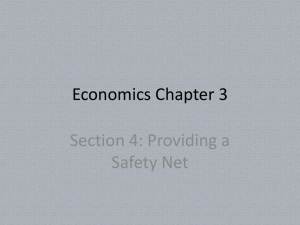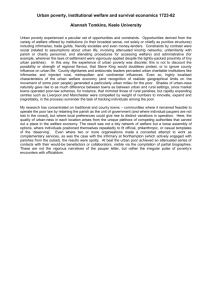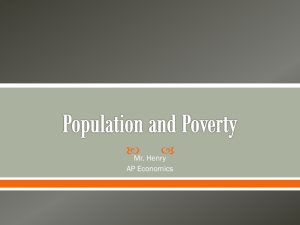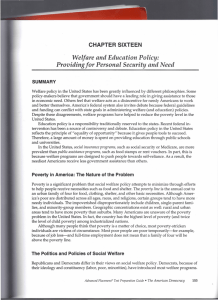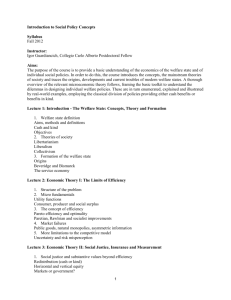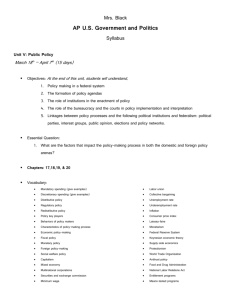Document 9982170
advertisement
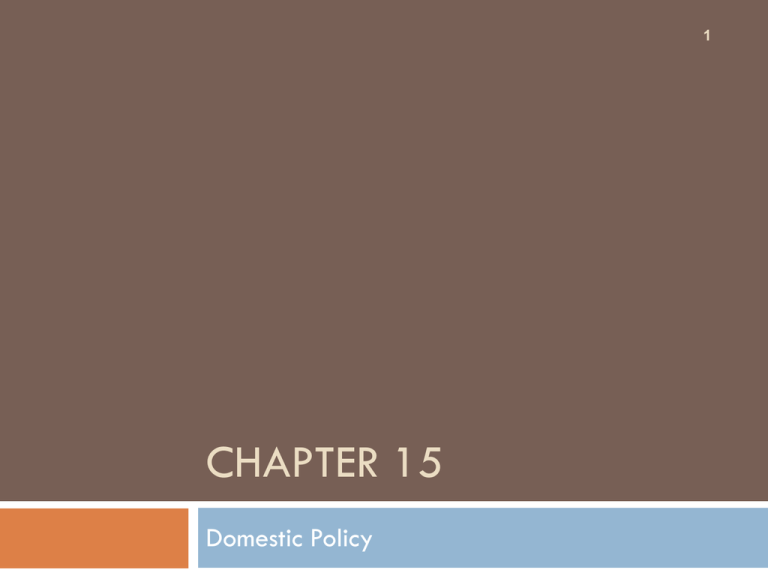
1 CHAPTER 15 Domestic Policy Debates Over Public Purposes 2 Domestic policy is a public policy that is comprised of decisions on matters affecting individuals within a political system. Domestic policy is affected by the self-interest of various groups and individuals. Self-interest is frequently cloaked in the mantle of national interest. Social welfare policies: governmental programs that are directed specifically toward promoting the well being of individuals and families (for example, social insurance programs) Social entitlements: programs whereby eligible individuals receive benefits according to law (for example, Social Security) Gross Domestic Product and Social Welfare Expenditures 1929-2000 3 In 1929, government at all levels spent less than 4 percent of GNP on social welfare programs. By the mid-1960s, government social welfare spending accounted for more than 10 percent of GDP. The largest category of social welfare spending is comprised of federal social insurance programs, followed by health and medical programs. Social welfare spending as a percentage of GDP gives an indication of how much society’s total output of goods and services is devoted to these programs. The Development of Federal Social Welfare Policy 4 The domestic activities of the national government before the twentieth century were very limited. Social Darwinism is a set of ideas applying Charles Darwin’s theory of biological evolution to society and holding that societal relationships occur within a struggle for survival in which only the fittest survive. The theory offered intellectual justification for limited government and unfettered growth of industry. According to this theory, government should not assume the role of providing for social welfare because such action would interfere with the natural forces acting to improve society as a whole. The Development of Federal Social Welfare Policy (continued) 5 The Progressive Era was an urban reform movement that called for direct primaries, restriction on corporations, and improved public services. It replaced corrupt politics with the civil service system. The New Deal encompasses the policy initiatives enacted during the first two terms of President Franklin D. Roosevelt in an effort to relieve suffering of those touched by the Great Depression. Revolutionary policy initiatives included the FDIC, Social Security, and unemployment compensation. It established a pervasive and active role for the national government. Public expectations that the government “do something” about social and economic problems arose during the Roosevelt presidency. The Development of Federal Social Welfare Policy (continued) 6 The Great Society was Lyndon B. Johnson’s term for the egalitarian society that was created by aggressive governmental action to help the poor and disadvantaged during the 1960s. The Civil Rights Act of 1964 and the Voting Rights Act of 1965 finally provided, by law, the rights long denied to African Americans. The Equal Opportunity Act and the Food Stamp Act of 1964 explicitly dealt with the plight of the poor. The Elementary and Secondary Education Act of 1964 provided federal aid for the nation’s disadvantaged schools. Perhaps the most important was the Social Security Act amendment in 1965 that provided health care for the aged (Medicare) and the poor (Medicaid). The National Government as Social Insurer 7 Social insurance programs are welfare programs that provide cash or services to the aged, disabled, and the unemployed, regardless of income level. The Social Security Act of 1935 was landmark legislation that firmly established, for the first time, a social welfare role for the national government by providing old age insurance, unemployment compensation, and grants to the states to provide cash assistance to dependent children and to the blind, disabled and aged. The National Government as Social Insurer (continued) 8 In terms of expenditures, numbers of people, and intensity of political support, Social Security is the national government’s largest and single most important domestic policy. By the late 1970s and early 1980s, it had become clear that with a declining birth rate and longer life expectancies the expenditures would soon exceed revenues. As a result, the future of Social Security has been an almost constant topic on the American political scene. Shares of Income for the Older Population, 2008 9 Older Americans rely heavily on Social Security income. Social Security benefits are the principle source of income for Americans over age 65. The National Government as Social Insurer 10 Medicare is a two-part public health insurance program in which government pays the providers of health care for medical services given to patients who are aged or disabled. Hospital Insurance (HI) is funded by a portion of the Social Security tax paid into a hospital trust fund. After a patient pays a deductible, Medicare covers hospital costs for two months. The patient shares costs after that period. The National Government as Social Insurer (continued) 11 Supplemental Medical Insurance (SMI) is a program that, after a patient pays a deductible amount, funds physician and outpatient services. SMI is voluntary. It is funded by premiums paid by enrollees and general revenues from the federal treasury. Unemployment compensation is a social insurance policy that grants temporary financial assistance to the unemployed. It is not designed for the chronically unemployed. It is for those who need financial assistance to keep afloat between jobs. Public Policy and Economic Inequality 12 A means-tested programs is a type of social welfare program in which the government provides cash or in-kind benefits to individuals who qualify by having little or no income. Measures of Economic Inequality Quintile: five groups each comprising a fifth of the population, divided according to the proportion of the total money each group receives Perfect income equality would mean that each fifth of the population of families receives 20 percent of all the money income—that each quintile receives an equal slice of the money pie. However, great income inequality persists as the lowest group receives only 3.4 percent of the money pie while the highest group receives 50 percent of the money pie. Public Policy and Economic Inequality (continued) 13 Another measure of economic inequality is the proportion of the total population classified as poor in the United States. The term poverty is a human construct and does not have the same meaning in all societies. Relative deprivation is one way to define poverty. This means that individuals with less, regardless of their absolute income level, will feel poor or deprived relative to those who have more. The poverty threshold is an income level, different according to family size and adjusted annually for inflation, below which individuals are defined as being poor. Major Social Welfare Programs 14 Social insurance and means-tested programs are major categories of social welfare programs. Social insurance programs are generally funded by specific taxes and have the retired, the aged, individuals with disabilities, and the unemployed as their beneficiaries. Means-tested programs are designed for needy individuals, are funded by general revenues, and usually involve the states in their administration. Aggregate Family Income by Quintiles 15 In the years between 1968 and 2008, the bottom four quintiles of families received a declining share of aggregate income, while the top quintile increased their share of aggregate income. Number and Proportion of Poor People in the United States, Selected years, 1960-2008 16 Although the absolute number of poor people remains high, the percentage of poor in the population has been below 14 percent in recent years. Poverty Rates for Selected Groups, Selected Years, 1959-2008 17 Although poverty rates are lower than they were in 1959, substantial differences among groups remain. Poverty as a Political and Social Problem 18 Social scientists have generally offered two sets of explanations for why people are poor. The first holds that people are poor because they lack personal qualities, such as ambition or intelligence. The second explanation centers on the kind of social, economic, and cultural environment that is likely to be fertile ground for poverty. The working poor are individuals who, despite being employed or seeking employment, are still defined as poor because their low earnings are not enough to put them above the poverty threshold. Poverty as a Political and Social Problem (continued) 19 The underclass is defined as a proportion of the poor comprised of individuals isolated from the rest of society and for whom poverty is a continuing way of life. Curative strategies are policy strategies designed to reach the fundamental causes of poverty and to enable individuals to get out of poverty and lead productive, self-sufficient lives. Alleviative strategies are policy strategies designed to make poverty more bearable for individuals rather than being designed to prevent poverty by reaching its fundamental causes. Aid to Families with Dependent Children (AFDC) was one of the oldest alleviate strategies that provided cash assistance to needy children and an adult relative or, in participating states, an unemployed parent. Poverty as a Political and Social Problem (continued) 20 Welfare programs were among the most controversial poverty programs because of the perception that it creates a “welfare dependency” that is passed from one generation of families to the next, with little hope of breaking out of the vicious cycle. Welfare Reform Act This act changed the name from Aid to Families with Dependent Children (AFDC) to Temporary Assistance for Needy Families (TANF), emphasizing the temporary nature of the program and placing a two-year limit on the receipt of benefits. It also required recipients to work at least part-time while receiving benefits and provided some exemptions for education and job training. Public Policies to Address Economic Inequality 21 Supplemental Security Income (SSI) is a social welfare program administered by the Social Security Administration whereby the national government guarantees a certain level of income for the needy, aged, blind, and disabled. Medicaid is a means-tested medical care program providing in-kind medical benefits for the poor. Supplemental Nutrition Assistance Program is a meanstested program that provides the eligible needy with cards that can be used to purchase food. Environmental Policy 22 Environmental protection policies are designed to regulate various types of pollution. The Environmental Protection Agency (EPA) is an independent agency that controls and abates air and water pollution and protects the environment from pollution from solid wastes, pesticides, radiation, and toxic substances. Risk assessment is the process of estimating the potentially dangerous consequences or damage that might result from a particular activity. Risk management is the process of making decisions that try to reduce or contain identified risks.
